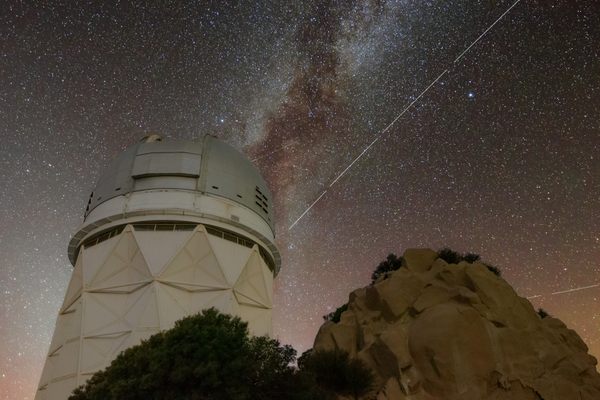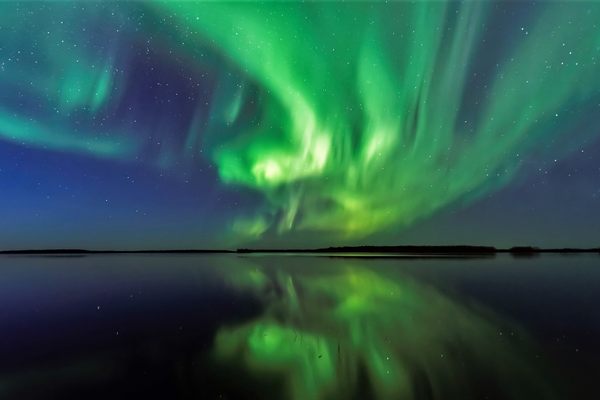Auroras Are the Sun’s Special Nighttime Light Show
As our day star enters its most active period, look for more opportunities to catch these spectral northern (and southern) lights. Here’s how.
Atlas Obscura’s Wondersky columnist Rebecca Boyle is an award-winning science journalist and author of the upcoming Our Moon: How Earth’s Celestial Companion Transformed the Planet, Guided Evolution, and Made Us Who We Are (January 2024, Random House). Throughout the summer, she’ll be sharing the stories and secrets of our wondrous night sky.
Stargazing is largely about celebrating stars other than the Sun. But there is one exception to this rule: when a rippling curtain of spectral green and sometimes red, pink, and purple descends across the upper latitudes of our planet. These space weather light shows, known as auroras, are the result of a specific sequence of events that starts with the Sun and ends in our atmosphere—and it might be happening this week.
Some space weather forecasters are calling for a major geomagnetic storm on Wednesday and Thursday nights, July 12 and 13. That means huge swaths of North America, Europe, and Asia could see the northern lights. (Auroras are also expected in Antarctica and possibly New Zealand and Australia, where they’re known as the southern lights.)
In the United States, auroras could be visible in 17 states, wherever there are clear skies. They may appear overhead in northern cities such as Minneapolis, and lower on the horizon in places like Indianapolis; Cheyenne, Wyoming; and Annapolis, Maryland. Both NOAA’s Space Weather Prediction Center and the University of Alaska Fairbanks’ Geophysical Institute offer free, real-time forecast tools to plan your aurora hunt worldwide.

To spot auroras, go somewhere dark, away from city lights. Aim for a place with a wide view of the horizon: an open field, a park, or better yet, a large body of water. Wait at least an hour or so after sunset for maximum darkness, and keep an eye on your chosen aurora forecast tool, which will show expected activity in windows of 30 minutes to three hours all night long.
This week’s potential show would be the second major auroral event in the last couple months. This is because the Sun is going wild right now, and we’re not even to the expected peak of its activity cycle. Solar scientists monitor an 11-year pattern of activity on the Sun, when it oscillates between an active state, churning out loads of solar flares, and a quiet or “minimum” phase. Think about this for a second: Our star, which is 4.6 billion years old, experiences maximum highs and lows on timescales that are short even for a human. We entered Solar Cycle 25 in December 2019, and the Sun’s peak activity, or “solar maximum,” is expected sometime in 2025.
The phenomenon of the aurora, called the aurora borealis in the northern hemisphere and the aurora australis south of the equator, makes Earth feel more like a planet from a fever dream, or at least a science fiction movie. From the ground, the lights appear as a ribbon dancing in the black sky, or a cascade of purple rain. Bright green often dominates at high latitudes, and the phenomena becomes fainter and redder as you go further south; Earth’s curvature blocks dazzling auroras in the lower atmosphere, so southern locations see a fainter, higher-altitude show.
The reason this solar show happens at all is thanks to one of Earth’s stranger features: its magnetic field.
In Earth’s molten core, flowing iron generates a current, which gives rise to a magnetic field that surrounds the planet like a protective shield. The magnetic field drives further electrical current in the core, so this process is self-sustaining. Not every planet has such a magnetic field, and on planets with stronger fields, such as Jupiter, the auroras are even more dramatic.

Meanwhile, the Sun constantly blows charged subatomic particles at us and the other planets, a phenomenon called the solar wind. These particles slam into Earth’s magnetic field, which sends them flying toward the planet’s poles, generating aurora. Sometimes, the Sun also ejects big parcels of plasma that fly toward our planet in raging clouds, a phenomenon called coronal mass ejections. These traveling tempests also crash into the magnetic field, causing it to bend as it absorbs the blow. These events can create powerful auroras visible at great distances from Earth’s poles. This all happens because the solar particles jostle molecules in Earth’s atmosphere, energizing them and lighting them up.
An aurora’s colors come from those energized atoms in Earth’s atmosphere. The knowledge of this physics is, to me, what makes the aurora so beautiful, and so profound to witness.
Purple comes from hydrogen, the most common element in the universe. Purple and blue also come from helium, that product of the Sun’s thermonuclear furnace. Pink and dark red come from nitrogen. And green, the most common aurora color we can see from the ground, comes from oxygen. This element would not exist in Earth’s atmosphere without the exhalations of photosynthetic life, from the tiniest cyanobacteria to the forest lungs of our planet. So in a very real sense, the aurora is not only a way of seeing our star’s physical connection to our world. It’s also a way of seeing life on this planet, life that exists because of our star.
Is there something you’d like to know about our brilliant night sky? Share your stargazing questions with us and you may see them answered in a future Wondersky column!









Follow us on Twitter to get the latest on the world's hidden wonders.
Like us on Facebook to get the latest on the world's hidden wonders.
Follow us on Twitter Like us on Facebook